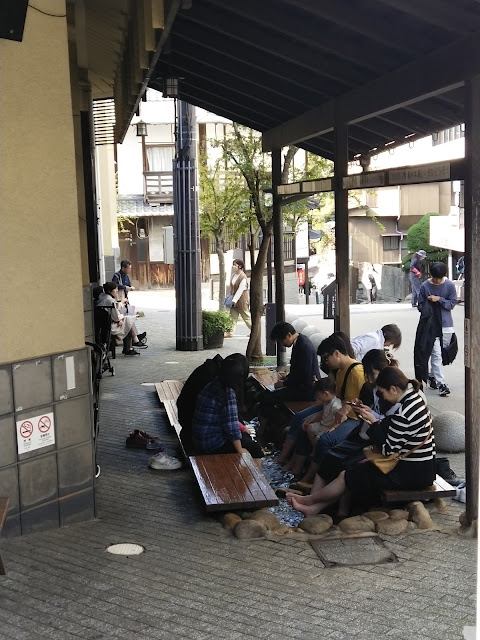Back in January I made a quick trip to Singapore, because I could, quite cheaply. I've only posted once about it, but I said I would make a separate post about Singapore's most unusual semi-touristy site to visit, Haw Par Villa.
Wikipedia confirms that it's only moderately famous now - there was an attempt to make it into a "theme park" but that didn't pan out, so now the large grounds are just open for free, with only one paid section, the cheerily named Hell's Museum, which is discussed below.
For the uninitiated, the grounds are the site of a former mansion and gardens built in the 1930's by the rich family which came up with Tiger Balm - a product still very much associated with Singapore.
Here's a photo of the mansion which, in a feat of poor timing, was finished in 1937:
The Japanese took it over after their invasion, ruined the place, and it was demolished after the war. Given it was such a distinctive modernist/art deco-ish design, I wonder if anyone has the internal floorplan: it would be extremely cool to see it rebuilt. Now, there's just some concrete where it used to stand:
The surrounding gardens were filled with a large number of somewhat eccentric looking dioramas mostly about Chinese and Buddhist folklore and morality - said to have been made to entice the builder's younger brother to come live with him in Singapore. So some of it dates back to the 1930's, although other parts (including I think the most famous part - the garish and luridly violent depiction of the 10 courts of Chinese Hell) was built after the war.
It's these weird and wonderful sculptures and dioramas, most of which are in reasonable repair, which people - although fewer over the years - come to see:
The Monkey King is at the top of that one:
There are many dioramas showing vices with a 1930's flavour:
Some sculptures (more modern ones I think) are just wacky for the sake of wacky, it seems:
But as mentioned above, the most famous section is the Chinese Hell part, which is now incorporated in the relatively new Hell's Museum, for which there is an $18 entrance fee.
To my pleasant surprise, this smallish but well curated Museum deals in a very erudite fashion with the whole question of belief in an afterlife in history and various cultures. It was obviously created with detailed input from one or more academics in the field of comparative religion. This is right up my alley - it felt very compatible with the Youtube content on Religion for Breakfast which I like watching. It's worth waiting for the free guided tour, which saves a lot of reading of quite extensive notes on the walls.
The tour ends in the enclosed area depicting various parts of Chinese Hell. Most scenes are graphically violent, but in such lurid way it's hard to take offence. From memory, it starts with a preliminary trial:
then the good proceed to Paradise via the Silver or Golden bridges:
but for the sinner, it's a look into the Mirror of Retribution:
and onto the various courts overseen by various Kings, with punishments designed for different types of sin. There didn't seem any particular rhyme or reason for the types of punishment to matching the sin, though:
Some court examples:
I think one of the above was for cheating students, and said to be the most popular for parents to show their kids (!). Oh yeah, it's in the one involving dismemberment.
Here we go - I assume this woman "caused trouble" for her parents?:
After (I think) 3 years of trouncing through Hell, the soul is given a herbal elixir in the Pavilion of Forgetfulness that causes them to forget everything about their past lives before they are reborn, as animal or human (or something else?), again depending on past karma.
I'm not sure how canonical this depiction is, so to speak. I think other versions have 18 courts, and I see on some website that the 10 courts are given these titles (which don't match up exactly with the Haw Par version?):
I'm particularly amused to see the "Office of Fair Trading" in there - although the "Sixteen Departments of Heart Gouging" also sounds amusingly bureaucratic.
Anyway, it seems clear that the downside of no internet, TV or cinema back in the day was too much time for people to imagine horrors. Although, I have to admit, there is a high degree of - um - entertaining elaborate adventurousness? about a lot of Chinese supernatural folklore, isn't there?
I didn't know about this Buddhist character, for example (see the sign following):
Yeah, yeah, I suppose Christians have St Michael slaying a dragon, and Jesus himself doing something ill-defined during the Descent into Hell: but if it were written by the Chinese, it would have been with a glowing sword with which 10,000 demons were slayed...or something more elaborate.
Finally, one of the oddest (and surely most photographed) sculptures is this one, which the guide said was intended to illustrate a folkloric story about the good young woman and mother who forsook her own hungry child to feed breast milk to her ill and hungry mother:
Yes, a heroine for filial piety: but a bit extreme for Western tastes.
So, as you can tell, I was very happy with this visit to a pretty uniquely eccentric, and actually educational (if you go into the Museum) place - I hope it manages to survive well into the future.


















































%20Trump%20bridge%20-%20Search%20_%20X.png)
%20Trump%20bridge%20-%20Search%20_%20X.png)
%20Trump%20bridge%20-%20Search%20_%20X.png)
%20Home%20_%20X.png)